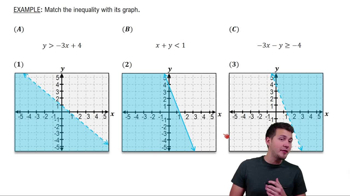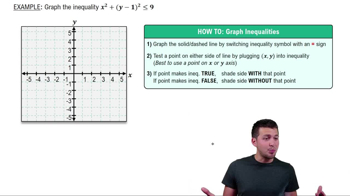Table of contents
- 0. Review of Algebra4h 16m
- 1. Equations & Inequalities3h 18m
- 2. Graphs of Equations43m
- 3. Functions2h 17m
- 4. Polynomial Functions1h 44m
- 5. Rational Functions1h 23m
- 6. Exponential & Logarithmic Functions2h 28m
- 7. Systems of Equations & Matrices4h 6m
- 8. Conic Sections2h 23m
- 9. Sequences, Series, & Induction1h 19m
- 10. Combinatorics & Probability1h 45m
7. Systems of Equations & Matrices
Graphing Systems of Inequalities
Problem 5a
Textbook Question
In Exercises 1–26, graph each inequality. y≤(1/3)x
 Verified step by step guidance
Verified step by step guidance1
Step 1: Start by identifying the equation of the line associated with the inequality. The inequality given is \( y \leq \frac{1}{3}x \). The equation of the line is \( y = \frac{1}{3}x \).
Step 2: Graph the line \( y = \frac{1}{3}x \). This is a straight line with a slope of \( \frac{1}{3} \) and a y-intercept of 0. Begin by plotting the y-intercept at the origin (0,0).
Step 3: Use the slope \( \frac{1}{3} \) to find another point on the line. From the origin, move up 1 unit and to the right 3 units to plot the next point (3,1).
Step 4: Draw a solid line through the points (0,0) and (3,1). The line is solid because the inequality is \( \leq \), which includes the boundary line.
Step 5: Shade the region below the line to represent the solution to the inequality \( y \leq \frac{1}{3}x \). This shaded area includes all points where the y-value is less than or equal to \( \frac{1}{3}x \).
Recommended similar problem, with video answer:
 Verified Solution
Verified SolutionThis video solution was recommended by our tutors as helpful for the problem above
Video duration:
5mPlay a video:
Was this helpful?
Key Concepts
Here are the essential concepts you must grasp in order to answer the question correctly.
Inequalities
Inequalities are mathematical expressions that show the relationship between two values when they are not equal. They use symbols such as ≤ (less than or equal to), ≥ (greater than or equal to), < (less than), and > (greater than). Understanding how to interpret and manipulate inequalities is essential for graphing them accurately.
Recommended video:

Linear Inequalities
Graphing Linear Equations
Graphing linear equations involves plotting points on a coordinate plane that satisfy the equation. The equation y = (1/3)x represents a straight line with a slope of 1/3. To graph the inequality y ≤ (1/3)x, one must first graph the line and then determine the region that satisfies the inequality, which is typically below the line.
Recommended video:

Categorizing Linear Equations
Shading Regions in Graphs
When graphing inequalities, it is important to shade the appropriate region of the graph to indicate all the solutions. For the inequality y ≤ (1/3)x, the area below the line, including the line itself, is shaded to represent all the points (x, y) that satisfy the inequality. This visual representation helps in understanding the solution set of the inequality.
Recommended video:
Guided course

Graphs & the Rectangular Coordinate System

 7:2m
7:2mWatch next
Master Linear Inequalities with a bite sized video explanation from Patrick Ford
Start learning





